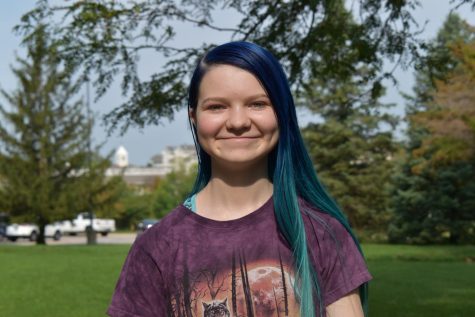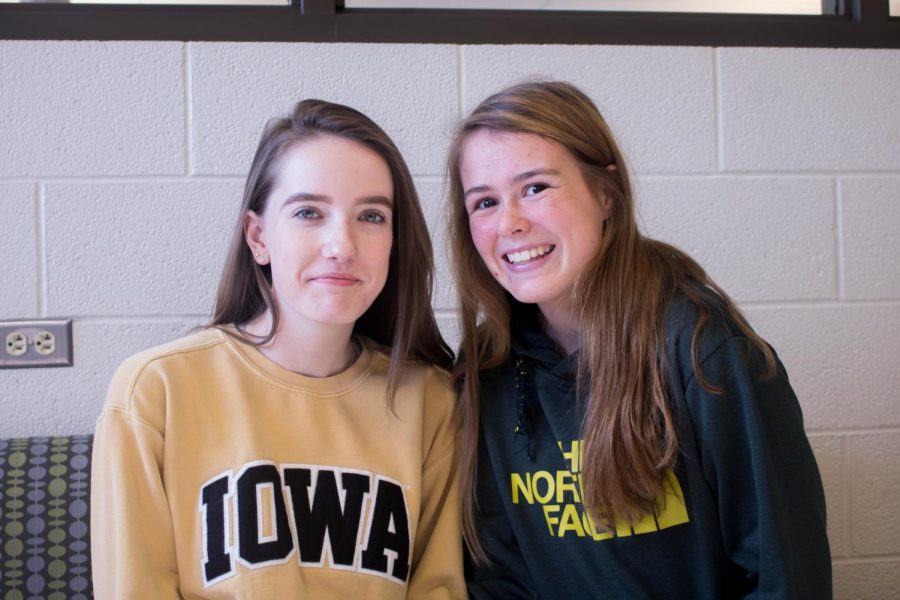Friend Crush: Mia Dillingham ‘20 and Mary Woodward ‘21
When Mia Dillingham ‘20 and Mary Woodward ‘21 want to talk in class, they don’t pass notes. Instead, they sign.
Mia Dillingham ’20 and Mary Woodward ’21 pose for a photo in the library.
Mia Dillingham ’20 and Mary Woodward ’21 met two years ago in cross country, completely unaware that they both knew sign language. They were sprinters, so they became friends over their shared love for the sport.
“When we first became friends it was more of, ‘Hey we’re both sprinters on the cross country team. Lets like hang out and go struggle through this together,’” Woodward said.
It wasn’t until later that they realized they both knew sign language.
Dillingham was born deaf but grew up in the “hearing world” because of her hearing aid. She grew up learning two languages, English and American Sign Language (ASL), but never learned to sign fluently because she would respond out loud.
“[ASL] wasn’t a big thing that I needed to know. It was just when I don’t have [my hearing aid] on, or when it would die sometimes, or when I swim,” Dillingham said. “And if my mom needed to communicate with me. Like I would do that, but I would always talk back to her and I would never sign back … You want to respond with your voice because you want to keep that [skill].”
Woodward is hearing, or not deaf, but started learning sign language because one of her friends was partially deaf. While she is not as fluent as Dillingham, she wants to keep learning to be able to communicate better.
“My grandfather is mostly deaf, and so I continually try and get him to learn so that we can communicate because he tends to just not listen, or pay attention to you,” she said.
Being deaf is not usually a problem during track or cross country because Dillingham has her hearing aids. However, before she got a new one, Dillingham used to have to take out her hearing aids when it rained. Without them, she could not hear when practice was done.
“We’d be running, and we’d be done,” Woodward said. “And so we’d all stop. But Mia wouldn’t be paying attention and she never remembers her watch so half the time we’re like ‘Mia!’ waving your arms, we’re like, ‘Let’s go this way. We’re done. Come on.’ Sometimes you’d just have her running around and we’re all waiting there like wait ‘til she turns the corner and she sees us.”
Even with her hearing aids, Dillingham often has trouble understanding people. She usually reads lips to help combat that, but sometimes people talk too fast or talk facing away from her, which can make understanding what they said difficult.
“It’s easier for me to hear you if I read your lips, which makes people a little uncomfortable because they’re like ‘Why are you staring at my lips like do you want to kiss me’ I’m like ‘No, no I’m just trying to hear you,'” Dillingham said.
Dillingham would have had less trouble with hearing, but as a child, she was stubborn in her belief that she did not need to wear both of her hearing aids.
“As a child I never wore [my left hearing aid] because I was like, I never needed the surgery, like I’m fine, I can hear perfectly,” Dillingham said. “And I wanted to prove to my mom that I can hear perfectly fine with only my right ear. Because I never wore it, my brain developed without having sound. So now when I put it on I get a migraine. So now I just don’t wear it.”
After they realized they both knew sign language, Dillingham and Woodward started using it to talk in AP Psychology. However, because of their different experience levels, they often had to resort to finger-spelling to be able to understand each other. Even though multiple students noticed, AP Psych teacher Amira Nash never did.
“We used to sit across from each other [in AP Psychology]. And so sometimes we [would] sign. And then she would spell words wrong,” Dillingham said.
“I would have to spell with my left hand, she couldn’t see my right hand and I’m dyslexic so spelling is basically like non-existent. So it was a bit of a struggle,” Woodward explained.
Aside from each other, Dillingham’s mother and a few friends, they do not know anyone else who knows sign language. While this means that they can communicate in class without anyone knowing, both of them wish that West taught ASL.
“It’s definitely like French or Spanish, where it’s useful,” Dillingham said. “I would love to see it in the schools, because I feel like the kids here would appreciate it more, because it’s a lot easier to learn, because there’s no written language to it like, ‘Oh, you have to spell something’ and then there’s like the squiggly line over this one or this one. So, I feel like it would be a lot easier … more appreciated and more useful.”
Your donation will support the student journalists of West High School. Your contribution will allow us to purchase Scholarship Yearbooks, newsroom equipment and cover our annual website hosting costs.

(she/her) Bess Frerichs is the online managing and feature editor. As a senior, this is her third and final year on staff. She enjoys reading, writing...




